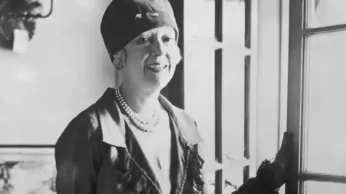
6 hours ago
How Elsie de Wolfe, a Trailblazing Lesbian, Invented Modern Interior Design
READ TIME: 3 MIN.
Elsie de Wolfe, born in New York City in 1859 (some sources cite 1865), stands as a singular force in the history of design, credited by *The New Yorker* and many historians as the inventor of the interior design profession. At a time when home interiors were dominated by heavy, ornate Victorian styles, de Wolfe’s vision was radical: she replaced dark wood and cluttered rooms with light, airy spaces, pastel colors, and a focus on comfort. Her approach—centered around the lived experience and personality of her often female clients—helped homes become expressions of individuality rather than just status.
De Wolfe’s career began on the stage, where she was known more for her stylish costumes than her acting prowess. Her keen eye for aesthetics led her from set design to redecorating her own home, and soon, through the encouragement of her close companion and theatrical agent Elisabeth Marbury, to professional interior decoration. Marbury was not just a business ally but also de Wolfe’s life partner in a relationship known as a “Boston marriage,” a term for long-term, intimate same-sex partnerships between women in an era when open discussion of sexual orientation was rare.
De Wolfe’s design philosophy was a direct rebellion against the dark, oppressive interiors of her childhood. She famously despised William Morris wallpapers and heavy Victorian furniture, recounting in her autobiography how she threw herself on the floor, sobbing in protest at her parents’ redecorating choices. Her mantra, “I’m going to make everything around me beautiful—that will be my life,” became a guiding principle for her work.
After retiring from the stage in 1905, de Wolfe’s career as a decorator took off when she landed the commission for the Colony Club—the first social club for women in New York City—thanks to the support of Marbury, Anne Tracy Morgan, and architect Stanford White. Her designs for the club, featuring mirrors, trellises, pale fabrics, and 18th-century French furniture, were a sensation. The light-filled, elegant spaces stood in stark contrast to the Victorian gloom, winning her celebrity clients such as Anne Vanderbilt, Condé Nast, and the Duke and Duchess of Windsor.
Her 1913 book *The House in Good Taste* codified her design principles: simplicity, suitability, and proportion. De Wolfe advocated for interiors that reflected the inhabitants’ personalities, especially women, empowering her clients to pursue comfort and style independently of male tastes.
Elsie de Wolfe’s personal life was quietly radical. Living openly with Marbury for decades, she was part of a vibrant lesbian social circle, which included influential women in the arts and society. Though public acknowledgment of her sexuality was muted due to the era’s constraints, their partnership was an open secret among New York and Parisian elites.
De Wolfe’s status as a queer woman in a male-dominated profession is especially significant for LGBTQ+ history. Her achievements paved the way for women—and lesbians in particular—to claim space as creative professionals, business leaders, and cultural innovators. As historian Jane Merrill writes, “Elsie de Wolfe’s work was inseparable from her identity and her relationships, which gave her the freedom to reject tradition and invent a new way of living”.
De Wolfe’s influence endures: her insistence on homes as sites of joy, comfort, and personal agency is now a mainstream value. The contemporary interior design profession, with its emphasis on lifestyle and inclusivity, owes much to her vision. Her legacy is a reminder that many of the “delightful things we enjoy today”—from beautiful interiors to Girl Scouts and modern nursing—have roots in the contributions of lesbians and other LGBTQ+ pioneers.
Recognizing de Wolfe’s role is not just a matter of historical interest; it affirms the importance of representation and visibility. As LGBTQ+ communities continue to push for recognition in all spheres, celebrating figures like Elsie de Wolfe underscores the creative and cultural impact of queer individuals across centuries.
For LGBTQ+ readers, de Wolfe’s story offers both inspiration and affirmation: beauty, creativity, and innovation flourish when diverse voices are empowered to shape the world around them.






